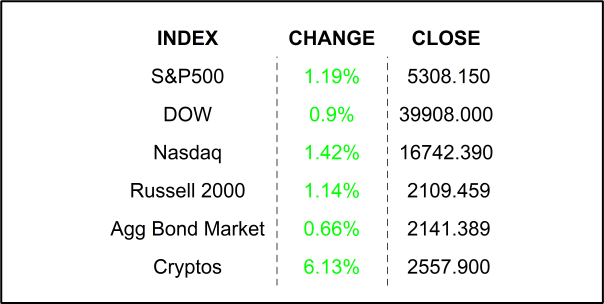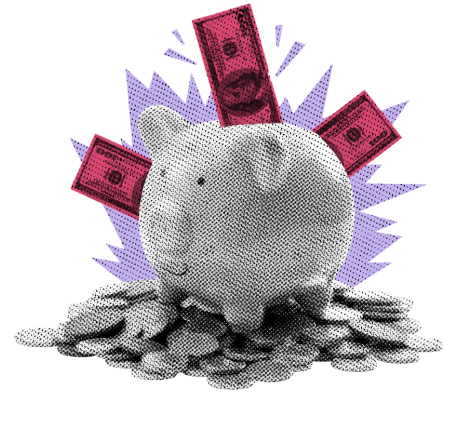
Stocks rallied to fresh highs yesterday in response to a monthly slowdown in Consumer Price Index / CPI. Retail Sales came in flat for the month indicating that consumers may be tightening their purses.
Great guess or inside information. Yesterday’s market action was all about inflation numbers, namely, the Consumer Price Index. As is customary, I will do a quick drill down into the release and reveal to you the culprit of this painful passage in our financial journey together. Wait, is it actually painful? I mean, the S&P500 and the Nasdaq are at all-time highs, so if you own stock, you are probably feeling pretty accomplished right now… assuming you own the right stock. That said, even if you do own the right stock and your account value is growing, you are probably anxious. If you are, don’t worry because you are not alone. Inflation is not at the Fed’s target and the Fed is doing its darndest to make sure we understand that it is going to keep its hands around the throat of the economy for as long as possible and remove them just before the economy loses consciousness. In other words, no rate cuts any time soon.
Anyway, here is your quick drill down into yesterday’s CPI release. Really quick. The topline month number came in at +0.3% month over month, less than the prior month’s +0.4% gain. For a second straight month, the Core Goods category dis-inflated. Core Goods are… things that you can hold in your hands. This category is what we all think about when it comes to inflation, but as we have known for some time, it is not those things that continue to vex the Fed. No, the Fed is worried about the Core Services category. In that category, you are probably thinking about how much your trip to the hairdresser has gone up in the past 18 months, but she is not the problem. Nope. Once again, the Shelter category comes in as the cause of trouble contributing some 59% of the entire services category’s monthly inflation. Going one level lower we find that Rent of Shelter, and even more specifically a category named Owner’s Equivalent Rent of Primary Residence is THE cause for sticky inflation, making up 73% of the shelter category’s monthly increase. Wondering what that category name means? The Bureau of Labor Statistics asks homeowners to estimate what they believe is a fair rent for their home. I am not making that up, you can go to the BLS website and look it up. So, inflation is still a problem, and because of that, the Fed is not going to lower interest rates just yet. Inflation is a problem because homeowners who were contacted by government pollsters think that the would-be rent of their homes are going up, even though they are not renting them out. I am not going to comment any further.
Now, here is something that is ACTUALLY interesting about yesterday’s CPI release. Did you know that the CPI number was accidentally released at 08:00 Wall Street Time… a half hour earlier than scheduled. If you download weekly economics calendars that attach and highlight EVERY MONDAY, you will know that 08:30 is when those, or any government data is typically released. Eugen Fama published a seminal work in 1970 entitled Efficient Capital Markets: A Review of Theory and Empirical Work. It introduces what some of you may know as the Efficient Market Hypothesis. That hypothesis is broken down into 3 parts: the weak form, the semi-strong form, and the strong form. The first suggests that all past trading information about a stock (like prices and volume) are already reflected in the stock’s current price. In other words, you can’t predict where a stock is going based on past trading information. In other words, it’s a random walk. Ok, the semi-strong form posits that all publicly available information about a stock is reflected in its current price. That makes sense, especially these days when the internet is full of information about stocks. The strong form boldly asserts that even inside information not available to the public is reflected in a stock’s current price. This paper has been cited some 38,000 times (that’s a lot, in case you are wondering) and is foundational in all finance education. If Fama’s assertions were strictly true, buying stocks would truly be random with no opportunity to exceed market performance. In other words, if you have beaten the market, it is purely luck. Invest in a dart board. Are you done chuckling? I can assure you that this is a very lively debate in not only academic circles, but also amongst hedge funds which manage around $5 trillion in assets, all promising to beat the market. Are you with me? Good, yesterday morning’s gaffe by the Bureau of Labor Statistics provides a perfect opportunity to test Fama’s famed hypothesis.
The monthly CPI was clearly known BLS prior to its scheduled release time. Blue chip economists were expecting the number to come in at +0.4%. That, according to Fama should be reflected in the stock market. Interestingly, the number was released a ½ hour early, and it came in lower than expected. Once public, the market should have reacted instantly. Check out the chart below and you will see that the market did ultimately react, but only once traders sought it out… at 08:30. So, not only does this event throw into question the semi-strong form, but also the strong form of the theory. Proof that sometimes, anomalies do occur. You just have to look hard for them. Put the darts down. And, if you want to read Fama’s article, here is the citation: Fama EF. EFFICIENT CAPITAL MARKETS: A REVIEW OF THEORY AND EMPIRICAL WORK. The Journal of finance (New York). 1970;25(2):383-417. doi:10.1111/j.1540-6261.1970.tb00518.x.

WHAT’S UP OR down IN THE PREMARKET
Deere & Co (DE) shares are down by -5.17% after announcing that it beat EPS and Revenue estimates. The company lowered its full-year earnings guidance to below analyst expectations citing softer demand. Dividend yield: 1.42%. Potential average analyst target upside: +2.2%.
Cisco Systems (CSCO) shares are higher by +3.26% after the company announced that it beat EPS and Revenue estimates by +7.60% and +0.36% respectively. The company raised its full-year revenue and profits targets above analysts’ estimates. In the past month, 7 analysts have increased their price targets while 1 has lowered them. The significance of Cisco’s bullish guidance revisions is that it implies that IT spending is picking up, which can be good news for all data-center related companies. Dividend yield: 3.22%. Potential average analyst target upside: +8.4%.
YESTERDAY’S MARKETS

NEXT UP
- Initial Jobless Claims (May 11) are expected to come in at 220k slightly lower than last week’s 231k claims.
- Housing Starts (April) may have grown by +7.6% after giving up -14.7% in March.
- Building Permits (April) probably climbed by +0.9% after sliding by -3.7% in the prior month.
- Industrial Production (April) is expected to have increased by +0.1% after adding +0.4% in the prior period.
- Fed Speakers: Barr, Barkin, Mester, and Bostic.
- Applied Materials and Take-Two Interactive are expected to announce earnings after the closing bell.
.png)

